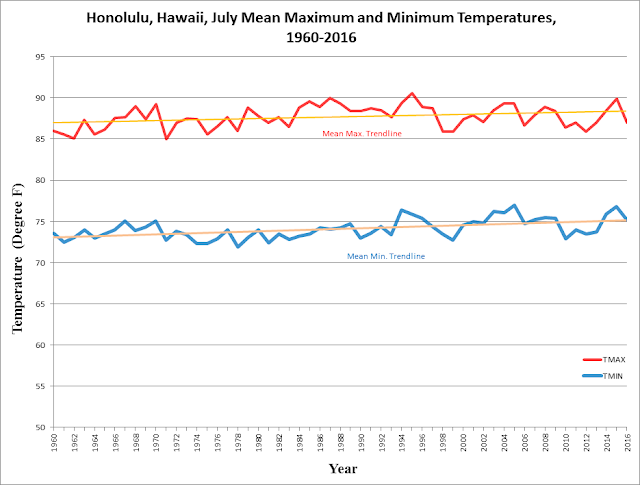Climate Controls
Honolulu has a tropical wet and a dry/savanna climate. The dry/savanna climate is associated with Honolulu’s dry, summer season. The tropical wet climate can be associated with the wet, winter season. There are numerous climate controls on a meso-scale and micro-scale that contributes to the climates in Honolulu.
Meso-Scale
There are two large mountains on the island of Oahu and the closest one to Honolulu is the Ko’olau Mountain. Honolulu is located on the leeward side of the mountain and the temperatures are impacted by the rain shadow effect. Honolulu is also in proximity to a large body of water, which is the Pacific Ocean. This causes Honolulu to have a high latent heat and humid air. The dominance of the maritime tropical air mass also affects the climate in Honolulu, which cause warm and moist temperatures all year round. Honolulu also experiences secondary atmospheric circulations such as the Hawaiian High-pressure cell and hurricanes. The Hawaiian high is associated with warm and calm weather, while hurricanes are associated with colder weather and more precipitation in the winter.
Micro-Scale
The Honolulu International Airport weather station is located right next to the Pacific Ocean. Therefore, the weather station is in proximity to a large reservoir, which can cause it to record a higher latent heat compared to sensible heat. As well, Honolulu is predominantly urban and contains lots of tall buildings. Therefore its temperature can be impacted by an urban heat island effect, which absorbs more of the sun’s energy leading to an increase in temperatures. Another micro-scale factor that affects Honolulu’s climate is the vegetation. Honolulu doesn’t have much vegetation because it is located on the leeward side. Hence, having less vegetation can cause the albedo to be lower which results in a higher absorption of the sun’s energy at the surface.
 |
| Koppen climate classification of Hawaii as a whole. According to this map, Honolulu is classified as an Am (monsoon) climate. Source: https://en.wikipedia.org/wiki/Climate_of_Hawaii |
 |
| The vast amount of tall buildings in Honolulu. There is also some vegetation in the area as well. Source: https://www.ncl.com/port-of-call/honolulu-cruises |
 |
| Here you can see that Honolulu is relatively dry compared to the other parts of Oahu island. Source: https://www.quora.com/What-island-is-Honolulu-on |
Temperature Trends in January and July over the past 50 years (1960-2016)
January
From 1960-2016, the maximum temperatures in January range from 75-85 ˚F and the minimum temperatures range from 60-70 ˚F. The highest maximum temperature was in 1996 at 84 ˚F and the lowest was in 1979 at 76.5 ˚F. The highest minimum temperature was 69.3 ˚F in 1964 and the lowest was 61.2 ˚F in 1969. The maximum trendline shows that the temperature has been stable with a slight increase. The minimum trendline shows that there has been an increase in the minimum temperatures.
July
In the past 50 years, the maximum temperatures in July range from 85-90 ˚F and the minimum temperatures range from 70- 77 ˚F. The highest maximum temperature was 90.6 ˚F in 1995 and the lowest was 85 ˚F in 1971. The highest minimum temperature was 77 ˚F in 2005 and the lowest was 71.9 ˚F in 1978. In general, the maximum and minimum trendlines show that there has been an increase in temperature during the past 50 years.
Honolulu (Honolulu Airport) vs. Maui (Kahului Airport)
Honolulu and Maui are both located in the Hawaiian Islands. However, Honolulu is a city located on the Oahu Island, while Maui is one of the Hawaiian Islands. In terms of Maui, the weather station of focus was the Kahului Airport. Both the Honolulu International Airport (HNL) and Kahului Airport (OGG) weather stations have warm, moist temperatures all year round. As well, the temperatures have never fallen below 60 ˚F throughout the past decades. Both of the weather stations don’t receive much precipitation; however, they both receive the most precipitation in the winter compared to the summer. These locations have a maritime climate, which can infer that they each have a high Bowen ratio above 0.5. They are both affected by the maritime tropical air mass and the Hawaiian high all year round. Another similarity is that they are both affected by orographic barriers like mountains, which causes them to receive warm, dry winds. They are also both affected by the cold front from a mid-latitude cyclone, which brings in the cold air in the winter. Another weather phenomenon both weather stations are affected by is tropical cyclones. There is not much of a weather difference between HNL and OGG except for their location. The HNL is located on the leeward side of the Ko’olau Mountain, while the OGG is located in a valley between the West Maui Mountains and the slopes of Haleakala on the east of OGG. As well HNL is located on the south shore of Oahu and OGG is located on the north shore of Maui.
 |
| Location of the Kahului and Honolulu. Source: https://www.google.com/maps/place/Kahului,+HI/ |
 |
| Comparison of the temperatures in Oahu and Maui Source: http://www.govisithawaii.com/hawaii-weather/ |
 |
| Comparison of the precipitation in Oahu and Maui Source: http://www.hawaiigaga.com/WeatherGuide.aspx |
Sources:
- http://www.to-hawaii.com/climate.php
- http://www.oahu.climatemps.com/
- http://manoa.hawaii.edu/hpicesu/book/1988_chap/13.pdf
- http://climate.ncsu.edu/edu/k12/.vegetation
- http://www.govisithawaii.com/2015/09/29/maui-weather-guide/
- http://www.mauiinformationguide.com/hawaii-weather.php
- http://www.mauiinformationguide.com/kahului.php
- http://apdl.kcc.hawaii.edu/earth/low.html
- Chambers, F. (2017). Modification to Energy Balances Lecture. Personal Collection of F. Chambers, University of Colorado Denver, Denver, CO.

